What is photosynthesis? It is a process by which green plants, algae, and some bacteria convert light energy into chemical energy, producing oxygen and glucose from carbon dioxide and water. It occurs mainly in the chloroplasts of plant cells, where chlorophyll pigments absorb sunlight. This process is vital for life on Earth, as it forms the foundation of the food chain, supplying energy to almost all living organisms. Photosynthesis also plays a crucial role in regulating atmospheric carbon dioxide levels, thereby influencing global climate patterns. Understanding this process is key to grasping how ecosystems function and how plants support life on the planet.
Photosynthesis
In a simple definition, Photosynthesis is a fundamental biological process that occurs in plants, algae, and some bacteria. It is the process by which these organisms convert light energy from the sun into chemical energy in the form of glucose (a type of sugar) and oxygen. This process is crucial for the survival of most life on Earth, as it provides the primary source of energy and organic molecules necessary for growth and sustenance.
Photosynthesis Definition
Photosynthesis is made up of two words. What are the two words that make the word photosynthesis? So the question ‘What is Photosynthesis’ can be partially understood by simply dissecting the word ‘Photosynthesis’. Photosynthesis is made up of ‘Photo ( Greek phōs)’ and ‘Synthesis (synthesis)’. With ‘Photo’ in the word Photosynthesis, it is meant light, while ‘Synthesis’ in Photosynthesis means ‘putting together’ or ‘Process’.
Photosynthesis in Higher Plants
Photosynthesis is carried out by most plants, algae, and cyanobacteria and such organisms are called Photoautotrophs, which are creatures that use light to perform photosynthesis. The production and maintenance of oxygen in the Earth’s atmosphere are mostly due to photosynthesis.
Photosynthesis Equation
If we actually start to sit and notice everyday things that take place in the universe, we will surely be dizzy all day! How can we not be? Just look at the plants! They, unlike humans, can’t move, but they make their own food! Isn’t it amazing? Actually, plants make their food with the help of sunlight, water, air and the process of photosynthesis.
In this section, we will be particularly discussing the Photosynthesis Equation. If you don’t even have any idea about it, worry not because we have everything covered here!
Formula of Photosynthesis
The formula for photosynthesis is a simplified representation of the process in which green plants, algae, and some bacteria convert carbon dioxide and water into glucose (sugar) and oxygen using light energy. The overall chemical equation for photosynthesis is:
6 CO2 + 6 H2O + light energy → C6H12O6 (glucose) + 6 O2
In this formula for photosynthesis:
- 6 CO2 represents six molecules of carbon dioxide.
- 6 H2O represents six molecules of water.
- Light energy refers to the energy absorbed by chlorophyll and other pigments from sunlight.
- C6H12O6 represents glucose, a simple sugar and the primary product of photosynthesis.
- 6 O2 represents six molecules of oxygen, which are released as a byproduct of the process.
This equation demonstrates the conversion of carbon dioxide and water into glucose and oxygen, driven by the energy of light absorbed by photosynthetic pigments. Photosynthesis is a fundamental process for the production of organic compounds and the release of oxygen into the atmosphere.
Photosynthesis Diagram
Different species perform photosynthesis in different ways.
- The process always starts with the absorption of light energy by proteins. Reaction centres are proteins that contain green chlorophyll as well as other coloured pigments/chromophores. These proteins are stored in organelles in plants. Chloroplasts are the name for these organelles.
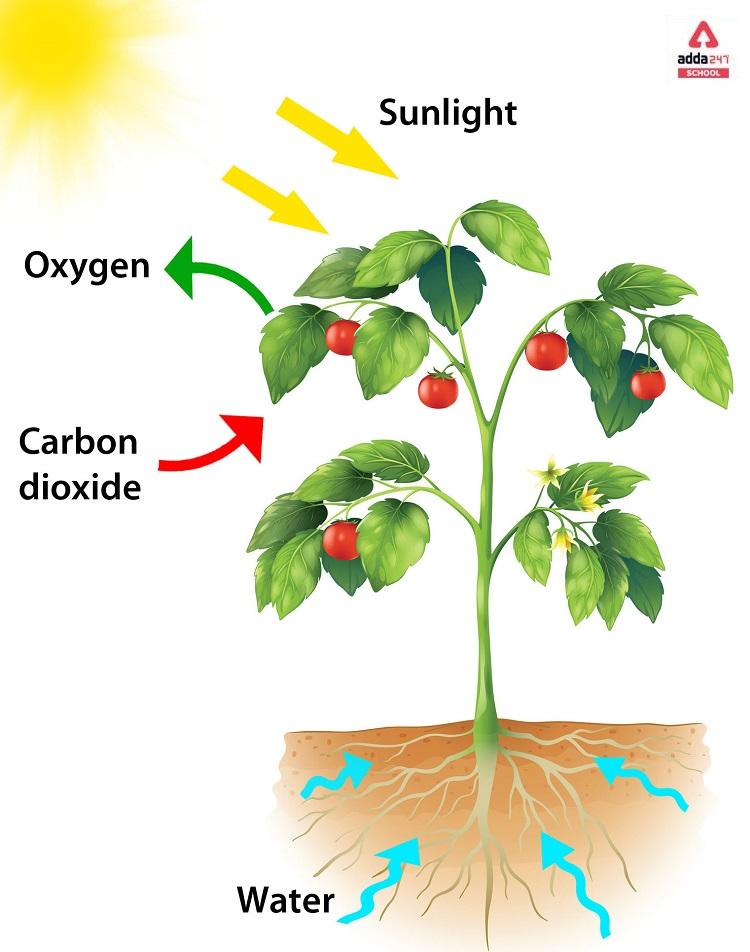
- Leaf cells have the highest concentration of chloroplasts. Chloroplasts are incorporated in the plasma membrane of bacteria.
- Some energy is utilised to extract electrons from appropriate compounds in these light-dependent processes. The hydrogen liberated during the splitting of water is utilised to make two more compounds. Short-term energy storage is provided by the chemicals. Reduced nicotinamide adenine dinucleotide phosphate (NADPH) and adenosine triphosphate (ATP), the “energy currency” of cells, are the molecules in question.
Photosynthesis Reaction
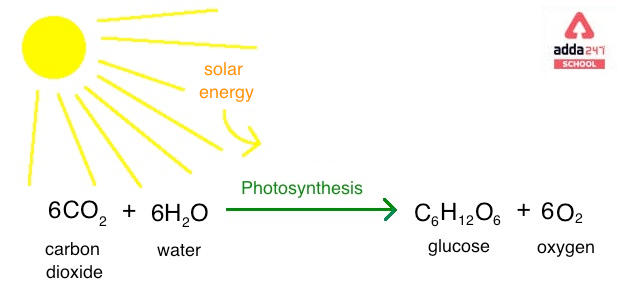
In this equation, carbon dioxide and water are converted into glucose and oxygen using the energy from sunlight. Photosynthesis is not only essential for plants but also plays a critical role in providing oxygen and food for other organisms in the ecosystem, making it a key process in the global carbon and oxygen cycles.
Photosynthesis Process
Here’s how photosynthesis works:
Light Absorption: Photosynthesis begins when light energy is absorbed by pigments in chloroplasts, which are the specialized organelles found in plant cells. The primary pigment responsible for capturing light energy is chlorophyll.
Light Reaction: In the presence of light, chlorophyll molecules in the chloroplasts become energized. This energy is used to split water molecules (H2O) into oxygen (O2) and protons (H+).
Electron Transport Chain: The energized electrons from water molecules move through a series of proteins and molecules in the thylakoid membrane of the chloroplast, known as the electron transport chain. This movement of electrons generates ATP (adenosine triphosphate), a molecule that stores and transfers energy.
Oxygen Production: During the electron transport chain, oxygen is released as a byproduct when water molecules are split.
Carbon Fixation: In the next phase, known as the Calvin cycle (or the dark reaction), carbon dioxide (CO2) from the atmosphere is fixed into a three-carbon compound known as 3-phosphoglycerate (3-PGA). This reaction is catalyzed by an enzyme called ribulose-1,5-bisphosphate carboxylase/oxygenase (RuBisCO).
Reduction and Sugar Production: ATP and NADPH, which were generated in the light reaction, are used to convert 3-PGA into a three-carbon sugar molecule, glyceraldehyde-3-phosphate (G3P). Some of the G3P molecules are used to regenerate RuBisCO and continue the Calvin cycle, while others are used to produce glucose and other organic compounds, which serve as an energy source and building blocks for plant growth.
Oxygen Release: Oxygen produced in the light reaction is released into the atmosphere as a waste product.
Anoxygenic and Oxygenic Photosynthesis
- Anoxygenic photosynthetic systems, such as those found in green and purple sulphur bacteria and green and purple nonsulfur bacteria, are likely to have existed in the early stages of evolution. Green sulphur bacteria are likely to have utilised hydrogen and sulphur as electron donors, whereas green nonsulfur bacteria employed different amino and other organic acids. The usage of a variety of nonspecific organic compounds by purple nonsulfur bacteria is compatible with geological evidence indicating Earth’s early atmosphere was strongly reducing at the time.
- Oxygenic photosynthesis is the primary source of oxygen in the Earth’s atmosphere. The oxygen disaster is the name given to the first occurrence of this high-energy molecule.
- The first photosynthetic organisms most likely developed early in life’s existence. Instead of water, the first photosynthetic organisms most likely utilised reducing chemicals like hydrogen or hydrogen sulphide as electron suppliers. Cyanobacteria appeared after the first photosynthetic organisms, but it was later.
- Cyanobacteria contributed directly to the oxygenation of the Earth by producing surplus oxygen. It is said to have paved the way for the evolution of sophisticated life. Photosynthesis currently captures around 130 terawatts of energy on a worldwide scale. It consumes around eight times the amount of energy that human civilisation now consumes.
Climate processes rely on photosynthesis. It absorbs carbon dioxide from the atmosphere and subsequently binds it in plants, soils, and harvested products.
Types of Photosynthesis
There are types of forms of photosynthesis – C3, C4, and CAM. The most common type of photosynthesis used by plants is C3. C4 and CAM photosynthesis are both adaptations to arid circumstances, as they improve water use efficiency.
Furthermore, CAM plants may “idle,” saving valuable energy and water during difficult times, and C4 plants can photosynthesize faster in the desert’s high heat and light circumstances than C3 plants because they use an extra metabolic route and specific morphology to limit photorespiration.
C3 Photosynthesis
- The vast majority of plants use C3 photosynthesis. During the Calvin Cycle, a three-carbon molecule known as 3-phosphoglyceric acid is produced, which is then converted into glucose.
- Stomata are open throughout the day.
- RUBISCO, the enzyme involved in photosynthesis, is also responsible for CO2 uptake.
- Photosynthesis occurs throughout the leaf.
- Adaptive Value: more efficient than C4 and CAM plants under cool and moist circumstances and under normal light since it requires less machinery (fewer enzymes and no specialised architecture).
C4 Photosynthesis
- C4 photosynthesis, on the other hand, generates a four-carbon intermediate product that is divided into carbon dioxide and a three-carbon compound during the Calvin Cycle.
- One advantage of C4 photosynthesis is that it produces larger levels of carbon, allowing plants to thrive in areas with limited light and water.
- PEP Carboxylase is the enzyme involved in the absorption of CO2.
- This enzyme permits CO2 to be swiftly absorbed by the plant and subsequently “delivers” it directly to RUBISCO for photosynthesis.
- C4 Photosynthesis occurs in inner cells (needs unique anatomy called Kranz Anatomy).
- Photosynthesizes more rapidly than C3 plants under high light intensity and high temperatures because CO2 is given straight to RUBISCO, preventing it from absorbing oxygen and undergoing photorespiration.
CAM Photosynthesis
- The acronym CAM stands for Crassulacean Acid Metabolism. CAM is named for the plant family in which it first appeared (Crassulaceae)
- This is because CO2 is stored in this process as an acid before being used in photosynthesis.
- Stomata open at night (when evaporation rates are often lower) and close during the day. The CO2 is transformed into an acid and stored at night.
- During the day, the acid is dissolved, releasing CO2 to RUBISCO for photosynthesis.
- In C4 photosynthesis, Better water use efficiency than C3 plants in arid environments because stomata open at night, when transpiration rates are lower.
- CAM plants comprise succulents like cactuses and agaves, as well as orchids and bromeliads.
| Related Articles | |
| Plant Cell Definition, Structure, Function | Respiration- In Plants and Human Beings |

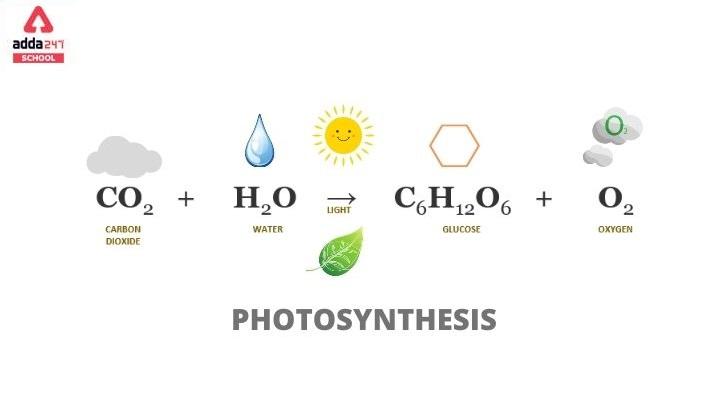







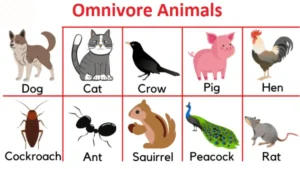 Omnivores Animals- Definition, Name List...
Omnivores Animals- Definition, Name List...
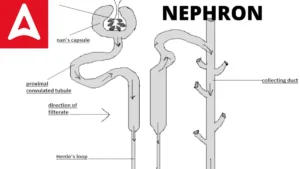 Nephron: Definition, Diagram, Structure,...
Nephron: Definition, Diagram, Structure,...
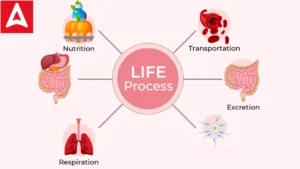 Life Processes: Check Nutrition, Transpo...
Life Processes: Check Nutrition, Transpo...









